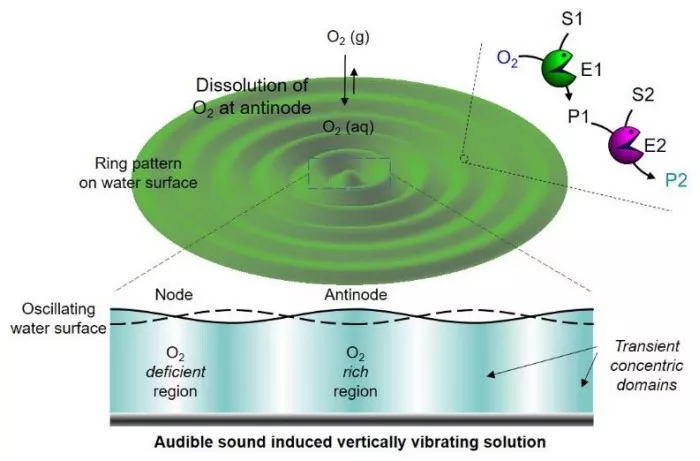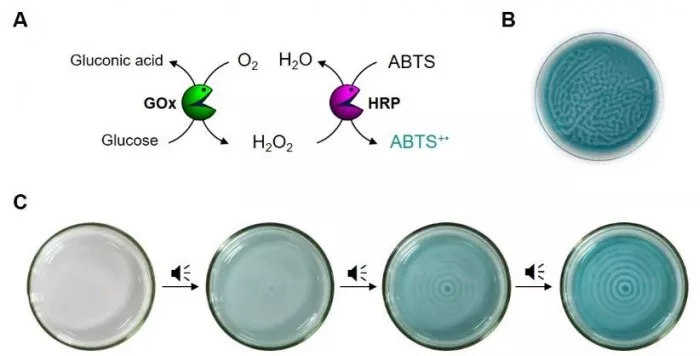In The Study Of Mimicking Natural Systems (such As Cells And Organelles), It Is Very Important To Spatio-temporal Control The Multi-step Enzyme Reaction By Separation. So Far, Scientists Have Used Liposomes, Vesicles Or Polymers To Physically Separate Different Enzymes And Function As "artificial Organelles".
But Now, The Research Team Led By Kim Kimoon, Director Of The Center For Self-assembly And Complexity At The POSCO Institute Of Basic Science In South Korea, Has Successfully Proved That Chemical Reactions Can Be Carried Out With The Same Timing [air Conditioning] Only With Audible Sound( ?site_id=242986&euid=&t=https%3A%2F%2Flist.jd.com%2Flist.html%3Fcat%3D737%2C794%2C870%26ev%3D1554_584894%26JL%3D3_%25E7%25A9%25BA%25E8%25B0%2583%25E7%25B1%25BB%25E5%2588%25AB_%25E7%25AB%258B%25E6%259F%259C%25E5%25BC%258F%25E7%25A9%25BA%25E8%25B0%2583%23J_crumbsBar ) Section, Which Is Completely Different From The Previous Method Described Above.
Although Sound Has Been Widely Used In Physics, Material Science And Other Fields, It Is Rarely Used In Chemistry. In Particular, Audible Sound (in The Range Of 20-20000 Hz) Has Not Been Used In Chemical Reactions Due To Its Low Energy. However, As Early As 2020, The Same Team From IBS Successfully Demonstrated For The First Time That Chemical Reactions Can Be Regulated By Selective Dissolution Of Gases In The Atmosphere By Standing Waves Generated By Audible Sound.
Figure 2 Spatiotemporal Control Of Glucose / GOx / HRP / ABTS Cascade Mediated By Audible Sound. (A) Schematic Diagram Of Glucose / GOx / HRP / ABTS Cascade Reaction. (B) The Randomly Shaped Pattern (c) Generated Without Applying Sound Changes In Time Dependence Of The Concentric Ring Pattern Obtained By Applying Sound Input (40 Hz). Source: Institute Of Basic Science
The Researchers Carefully Observed The Movement Of The Solution Induced By Audible Sound And Found That Due To The Node Area Of The Wave, The Solution Was Separated Rather Than Mixed Together, As If Different Layers Were Blocked By An Invisible Wall. They Called The Transient Domain Of The Solution Generated By Audible Sound "false Stratification" And Used It To Control The Enzyme Based Cascade Reaction Network In The Solution. In This Phenomenon, The Liquid Flow Induced In A Container Vibrated Up And Down By Audible Sound Will Not Mix With Each Other Around The Nodes Of The Wave, So The Solution Will Be Naturally Separated.
This New Discovery Inspired The Team To Use This Phenomenon To Try To Spatio-temporal Regulation Of Multi-step Enzyme Reactions. Typically, This Requires The Use Of Lipids Or Polymers To Create Artificial Compartments, But Kim's Team Has Shown That This Can Be Done Using Only Audible Sound. In Order To Achieve This Goal, They Designed A Smart System Based On The Fact That The Oxygen In The Air Is Only Dissolved In The Anti Node Area Of The Vibrating Solution.
Figure 3 (A) Audible Sound And Spatiotemporal Control Of Enzyme Mediated Gold Nanoparticle Assembly. Color Concentric Patterns And TEM Images Are Taken From Each Region Of The Pattern. (B) Nanoparticle Patterned Hydrogels (left) And Their Utilization For Selective Cell Growth (right). In The Fluorescence Microscope Image, The Red Spots Represent HeLa Cells On The Surface Of The Patterned Hydrogel. Source: Institute Of Basic Science
To Test The System, Kim's Team Conducted A Multi-step Enzymatic Reaction Consisting Of Glucose Oxidase (GOx) And Horseradish Peroxidase (HRP). In The First Step, GOx Enzyme Catalyzes The Oxidation Of Glucose And Produces Hydrogen Peroxide. In The Second Step, HRTs Is Used To Oxidize The Colorless Dye ABTS. If Cyan Appears In A Specific Area Of The Solution, Researchers Will Know That Their System Works As Planned.
As Expected, The Authors Were Able To Visually Observe The Cyan Concentric Ring Pattern, Which Confirmed That They Could Successfully Spatio-temporal Control The GOx HRP Cascade With Only Sound (Fig. 2). The Authors Further Show That This Method Can Be Extended To Control The PH Responsive Self-assembly Of Nanoparticles In The Space-time Domain Of Redox Driven In-situ Growth Or Solution. (Figure 3a). In Addition, The Author Also Introduced The Preparation Of Nanoparticle Pattern Hydrogels, Which Only Contain Self-assembled Particles In Selected Regions. These Gel Can Be Used For Cell Growth Platforms In Specific Areas (Fig. 3b).
"This New Approach Using Audible Sound Will Provide A New And Reliable Strategy To Control Chemical Processes In Predictable But Instantaneously Generated Pseudo Blocks In Solution," Kim Explained.



